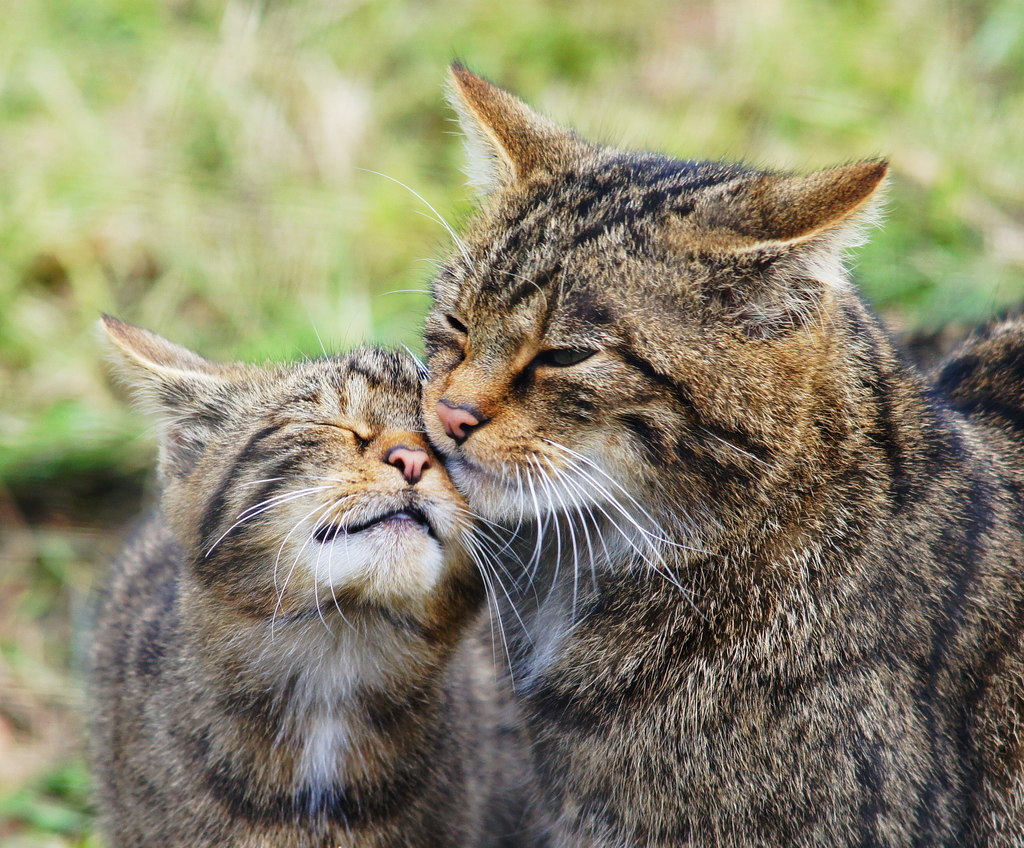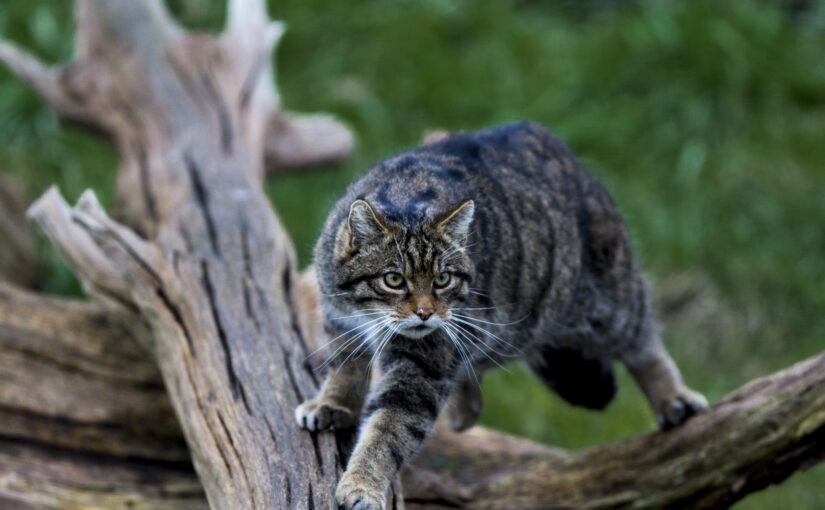Hidden in the quiet depths of Europe’s ancient forests lives a cat with roots stretching back to the wild dawn of the continent. The European wildcat, Felis silvestris silvestris, is a creature of both myth and reality. Once known as the “British tiger” in the eighteenth century, this untamable feline wandered from Scotland’s highlands to the mountains of Turkey and the broad forests of Central Europe. Though it resembles the familiar pet snoozing at the end of a sofa, the European wildcat is a different beast entirely. Stockier, wilder, and true to its ancient ways.
The wildcat stands taller and heavier than the domestic cat, with longer legs and a broad, powerful head. Its bushy tail, banded and tipped in black, is shorter than the tails of housecats, giving it a look of compact power. On average, the European wildcat is 30 to 35 centimeters high at the shoulder, weighs between four and eight kilograms, and streches from fifty to eighty centimeters in length, not counting a tail that adds up to another thirty-five centimeters. Males are typically bigger than females, both in length and heft, the better to defend territories or hunt in the deep woods.
Its coat is dense and protective, colored in shades of yellowish gray. Black stripes ripple along the flanks, while a single dark stripe runs down the center of the back. The throat is usually cream or bright white, contrasting with the grizzled body. Up close, every muscle and every line of fur suggests the animal’s function, a superb, efficient hunter built for stealth and power. In the words of those who admire it, the European wildcat is a “very functional-looking cat.”
Despite its fierce looks, from a distance, the wildcat may be mistaken for an oversized tabby. Yet looks can deceive. This animal has none of the softness or adaptability that characterizes the domestic cat. The European wildcat is both aggressive and fiercely independent. It has played no role in the evolution of the housecat and lacks the genetic flexibility to ever adapt to life alongside people. Even if a kitten is raised by hand, it remains wild at heart, unwilling to surrender its independence and always ready to escape at the first opportunity.
Unlike many of its relatives, the European wildcat is chiefly a creature of daylight. It prefers the calm of the forests to the chaos of human settlements, shunning villages and farms except for the rare and dangerous excursion to a chicken coop. Its principal prey is the mouse, but it is equally adept at catching birds, lizards, and even insects when hunger strikes.
The relationship between humans and the wildcat has not always been neighborly. Historical efforts to eradicate the wildcat were almost successful. Seen as a threat to livestock and an unwanted pest, the species was hunted, trapped, and driven from much of its original range. Yet, following the turmoil of the Second World War, fortunes shifted. The forests of Western, Central, and Southern Europe echoed once more with the silent tread of wildcats as habitats recovered and hunting pressure lessened.
Today, the European wildcat’s story is one of quiet resilience. It can be found in healthy populations in the woodlands of Germany, France, the Balkans, and across the Carpathian arch. It endures in the wilder parts of Scotland, the forests of Turkey, and into the Caucasus, though it has vanished from Scandinavia, England, and Wales. Its return was not the result of breeding in captivity or reintroduction, but rather the wildcat’s own determination to reclaim its lands.
Wildcats are true solitaries. For most of the year, each adult roams its territory alone, marking boundaries and hunting without company. Only when February’s first hints of spring fill the air do these secretive cats seek each other out. The mating rituals are brief, passionate, and noisy, with males competing fiercely for access to females. After a gestation of about nine weeks, the female slips away to a hollow or hidden den, where she births a litter of two to six kittens, their eyes remaining shut for the first week or two.
The kittens are quick to learn. By twelve weeks, they are following their mother on hunting trips, each pounce honing the skills that will sustain them. By four or five months, most will disperse to find their own patch of forest or moor. Maturity arrives at eleven months, turning the cycle once more to solitude and self-reliance.

The lifespan of a wildcat is remarkable for a small carnivore. Adults often live to fifteen or seventeen years, and some endure more than two decades under the cover of dense trees and shifting seasons.
The wildcat remains wary of people, giving a wide berth to villages and roads. Its only brushes with humanity now are occasional misadventures with poultry, which still rouses the old animosities. Yet these wild animals are not meant for taming. Captive wildcats rarely settle, retaining their untamed spirit across generations.
To watch a European wildcat is to glimpse the ancient soul of the continent’s forests. It is a reminder that beneath our managed landscapes, true wildness persists, fierce, wary, and beautifully adapted to the rhythms of nature. As long as these wild cats haunt the woods, Europe’s wilderness remains a little fuller, its old heartbeat a little stronger, and the dream of wild freedom alive.
The British Wildlife Centre
Wild cats hold a special fascination at the British Wildlife Centre, where conservation is at the heart of their mission. Among the Centre’s most charismatic and crucial animals is the Scottish wildcat, often called Britain’s “Highland Tiger.” Wildcat conservation efforts are particularly urgent, as this species is one of the UK’s rarest and most threatened mammals. Once widespread across Britain, the wildcats have been pushed to the brink by habitat loss, persecution, interbreeding with domestic cats, and disease. Today, pure Scottish wildcats are scarce, and many of those roaming the Highlands carry hybrid genes.
To address this crisis, the British Wildlife Centre works in partnership with national initiatives such as the Saving Wildcats project and contributes to the national captive breeding studbook. Their dedicated breeding program aims to safeguard and increase the genetic purity of Scottish wildcats by caring for and breeding individuals with the most authentic wildcat traits. The Centre’s wildcats are part of official conservation breeding efforts, carefully managed to support both genetic diversity and behavioral readiness for life in the wild. Human contact with breeding cats and kittens is deliberately minimized. This hands-off approach gives future wild-released animals the natural wariness and hunting skills they need for survival.
Conservation at the Centre is about more than just breeding. The team actively educates visitors about the importance of the wildcat and the challenges it faces. Through signage, keeper talks, and outreach, they explain the differences between wildcats and feral domestic cats, the importance of habitat protection, and what risks such as disease and road traffic pose to the fragile population. This educational work helps foster support for reintroduction projects and informs the public about what they can do to help native wildlife.
The British Wildlife Centre also works closely with larger projects that are making headlines in the wild. The Saving Wildcats consortium, for example, has successfully bred wildcat kittens for the purpose of release in Scotland’s Cairngorms National Park, supporting this effort with expertise, resources, and healthy breeding stock. Releases are carefully planned to coincide with the development of self-sustaining prey populations and suitable habitat, giving the cats the best possible chance for survival and resilience in the wild.
Conservation of wild cats at the British Wildlife Centre illustrates how science, community engagement, education, and practical breeding action come together to give Britain’s rare felines a fighting chance. Every kitten born represents hope not just for its species, but for wild nature in the British Isles. With careful stewardship and public support, the Centre aims to secure a future where the wildcat’s yowl will echo through the woods once again.
Teaser image by British Wildlife Centre.
If you find joy in these tales of twitching whiskers and gleaming eyes, consider helping keep Whiskerito.com alive and purring. Your donation supports thoughtful research, engaging content, and the warm, wonder-filled community that makes this space what it is.
